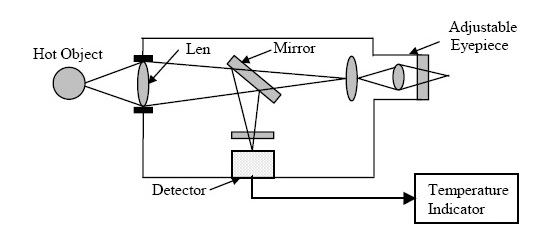Difference between Absolute, Gauge and Differential Pressure Transmitters
Difference between Absolute, Gauge and Differential Pressure Transmitters
To select the right pressure sensor for a specific application besides the pressure range first of all the type of pressure measurement has to be considered. Pressure sensors measure a certain pressure in comparison to a reference pressure and can be divided into absolute, gauge and differential devices. These terms will be explained on the basis of the piezoresistive pressure sensors.
Fig : Principle of an absolute pressure sensor (piezoresistive technology)
Examples
Gauge pressure sensors only offer one pressure port. The ambient air pressure is directed through a vent hole or a vent tube to the back side of the sensing element and thus compensated.
Fig : Principle of a gage pressure sensor (piezoresistive technology)
Examples
Fig : Principle of a differential pressure sensor (piezoresistive technology)
Examples
To select the right pressure sensor for a specific application besides the pressure range first of all the type of pressure measurement has to be considered. Pressure sensors measure a certain pressure in comparison to a reference pressure and can be divided into absolute, gauge and differential devices. These terms will be explained on the basis of the piezoresistive pressure sensors.
Absolute pressure
Absolute pressure is referred to the vacuum of free space (zero pressure). In practice absolute piezoresistive pressure sensors measure the pressure relative to a high vacuum reference sealed behind its sensing diaphragm. The vacuum has to be negligible compared to the pressure to be measured.Fig : Principle of an absolute pressure sensor (piezoresistive technology)
Examples
- Absolute pressure sensors are used to measure atmospheric pressure barometers or altimeters.
- Further, absolute pressure sensors ensure that a fixed vacuum pressure is applied in vacuum packaging machines to seal and preserve food independent of the local daily air pressure.
Gauge pressure
Gauge pressure is measured relative to the ambient atmospheric pressure. The average atmospheric pressure at sea level is 1013.25 mbar. Changes of the atmospheric pressure due to weather conditions or altitude directly influence the output of a gauge pressure sensor. A gage pressure higher than ambient pressure is referred to as positive pressure. If the measured pressure is below atmospheric pressure it is called negative or vacuum gauge pressure. In general a vacuum is a volume of space that is essentially empty of matter. According to its quality vacuum is divided into different ranges such as e.g. low, high and ultra high vacuum.Gauge pressure sensors only offer one pressure port. The ambient air pressure is directed through a vent hole or a vent tube to the back side of the sensing element and thus compensated.
Fig : Principle of a gage pressure sensor (piezoresistive technology)
Examples
- A typical example of a gauge pressure measurement is the control of tyre pressure. Here, the correct positive pressure above ambient pressure determines optimum tyre performance.
- During hydrostatic liquid level measurement in vented tanks or open containers barometric pressure changes have to be compensated to avoid false level indications. Both submersible level probes with a vent tube as well as externally mounted threaded pressure transmitters with a vent hole can be employed.
Differential pressure
Differential pressure is the difference between any two process pressures p1 and p2. Therefore, differential pressure sensors must offer two separate pressure ports with tube or threaded connections. Generally these pressure sensors are able to measure positive and negative pressure differences, i.e. p1>p2 and p1<p2. These sensors are called bidirectional differential pressure sensors with ranges of e.g. -1…+1 bar or -2.5…+2.5 mbar. In contrast, unidirectional differential pressure sensors only operate in the positive range (p1>p2) e.g. from 0…1 bar or 0…2.5 mbar and the higher pressure has to be applied to the pressure port defined as “high pressure”.Fig : Principle of a differential pressure sensor (piezoresistive technology)
Examples
- Differential pressure sensors are used e.g. in industries to determine flow or in HVAC applications to control air flow. An installed orifice plate in the pipeline generates a minimal pressure drop to the process flow which is a measure of the volumetric flow rate. Differential pressure sensors measure this pressure drop across the element & calculates equivalent flow.
- The same principle is used in filter monitoring. When the filter starts to clog the flow resistance and therefore the pressure drop across the filter will increase. Differential pressure sensors control this pressure drop and trigger an alarm if critical values are reached







Comments
Post a Comment